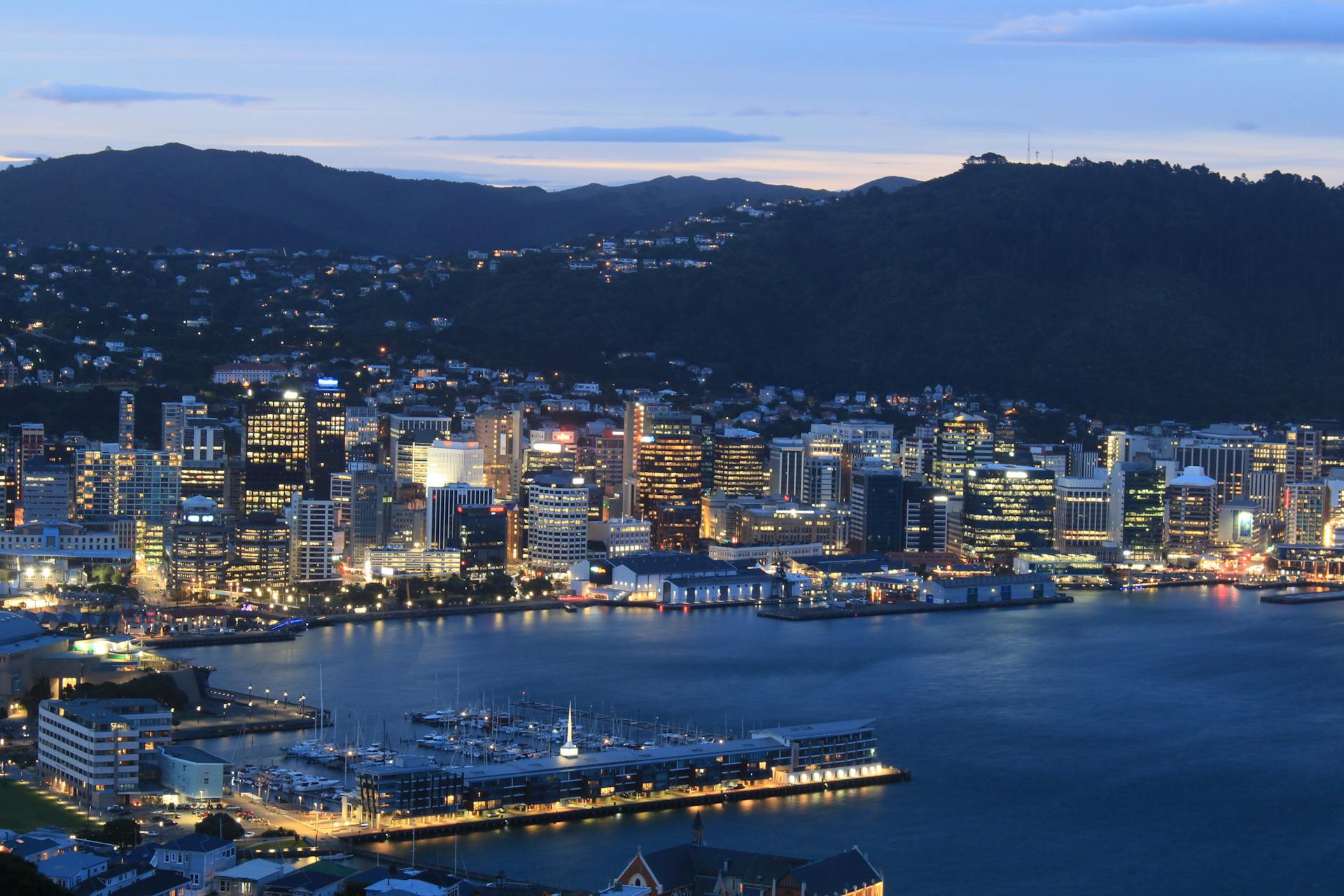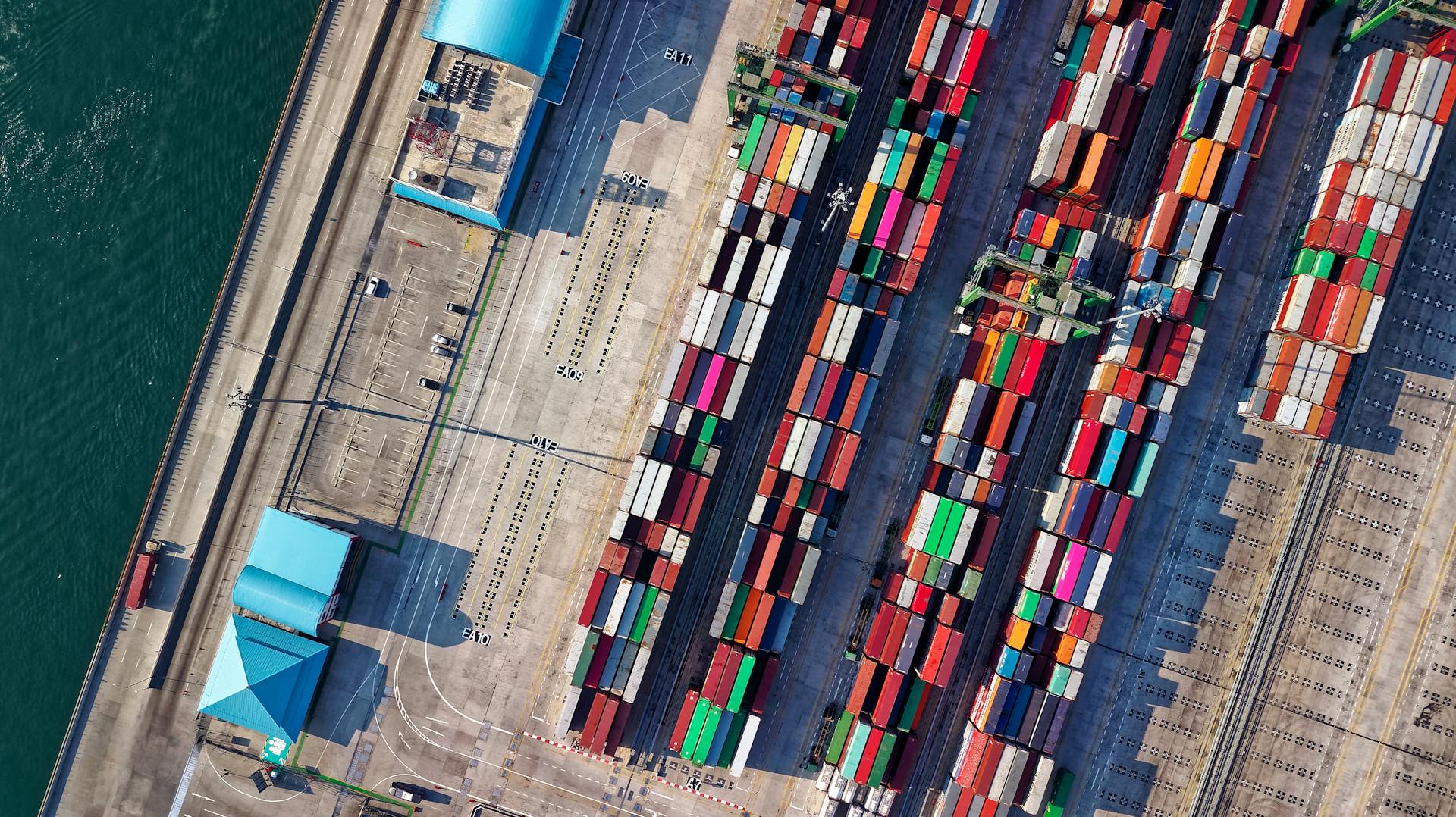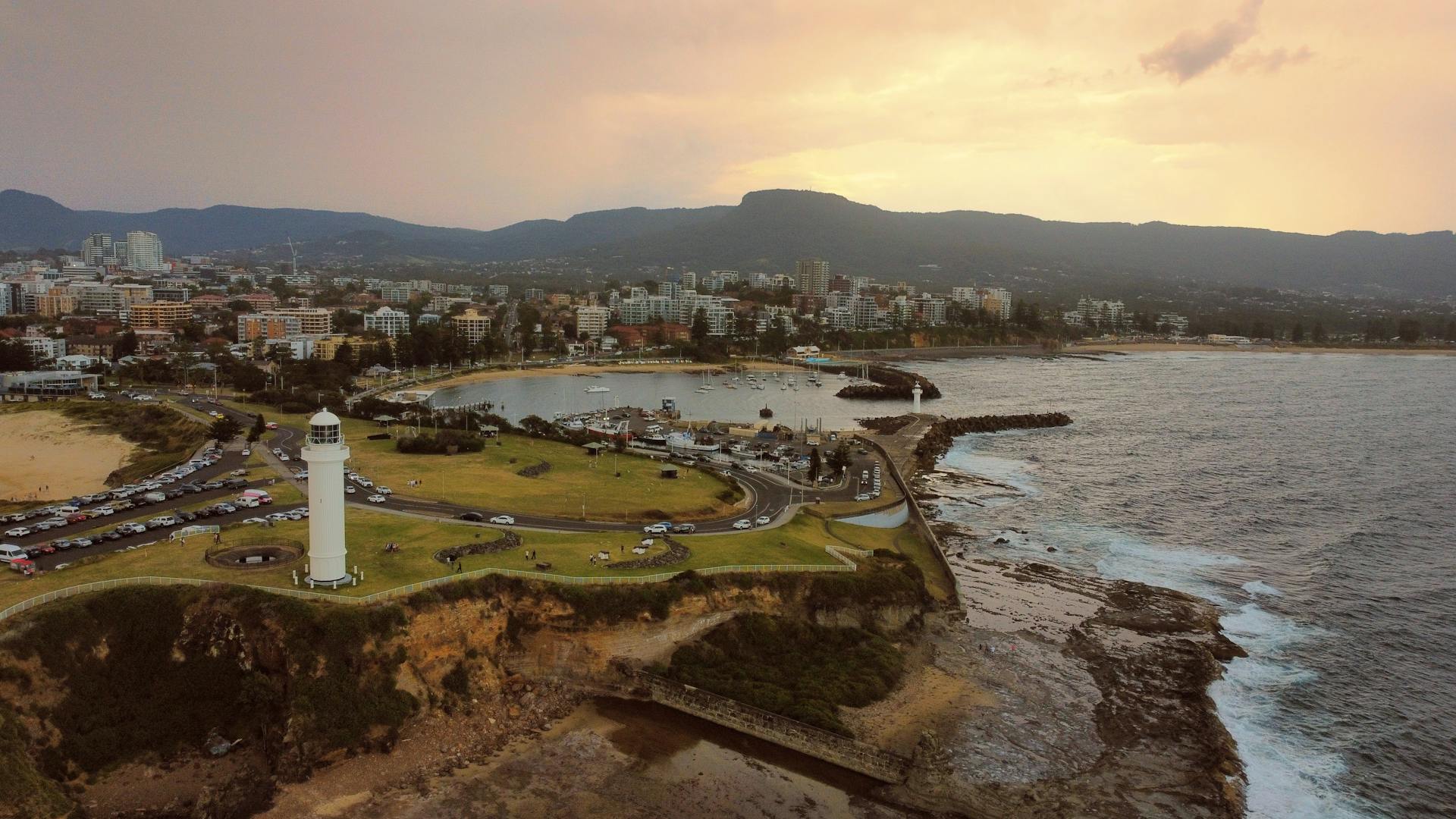
Wollongong Harbour Precinct has undergone significant transformations over the years, with a major focus on revitalization and expansion. The precinct has been transformed into a vibrant and bustling area, attracting tourists and locals alike.
The harbour precinct's evolution began in the 1990s with the redevelopment of the waterfront area. This involved the construction of new buildings, parks, and amenities, which helped to create a more inviting and engaging space for visitors.
One of the key features of the precinct is the Wollongong Harbour Foreshore, a scenic area that offers stunning views of the harbour and surrounding coastline. The foreshore is a popular spot for picnics, barbecues, and other outdoor activities.
The precinct's expansion has also led to the development of new businesses and services, including restaurants, cafes, and shops.
History
Wollongong Harbour Precinct has a rich history dating back to the 1820s when the area was used as a shipping point for the newly settled area.

The first recorded activity in the harbour was the transfer of shipments of supplies, produce, and timber destined for the Sydney market by small flat-bottomed boats or floated out.
In 1829, the regiment stationed at Red Point was relocated to the Boat Harbour at Brighton Beach, marking the beginning of the harbour's significance as a commercial, judicial, and administrative centre for Wollongong.
The construction of government buildings, barracks, and a stockade for the convicts adjacent to the harbour solidified its status as the main hub for the area.
Governor Bourke proclaimed the town of Wollongong as surveyed by Major Thomas Mitchell in 1834, after a visit to the Illawarra in April of that year.
The Customs House was originally a small weatherboard building on Brighton Lawn, but it was later relocated to the old Courthouse in Market Street in 1885.
Most of the principal changes at Wollongong Harbour since 1948 have been the removal of working appliances associated with a trading port, including cranes and the Illawarra Steam Navigation Company's coaling staithe and store.
The Pilot/Harbourmaster was withdrawn in 1955, and the station was progressively demolished in the 1960s, marking the end of an era for the harbour.
Infrastructure and Facilities
The Wollongong Harbour Precinct's infrastructure and facilities are a key part of its charm.
The precinct is home to a range of amenities, including a marina, a boat ramp, and a fishing jetty.
These facilities cater to both locals and visitors, providing easy access to the water for a variety of activities.
The precinct also features public art installations, adding to its unique character and aesthetic appeal.
Expansion Works
Expansion works are crucial for modernizing and upgrading existing infrastructure. Many cities have expanded their airport terminals to accommodate growing passenger traffic, increasing the number of gates and check-in counters.
The expansion of the city's water treatment plant has allowed it to serve a larger population, treating over 10 million gallons of water per day. This has helped to reduce the risk of water-borne diseases and ensure a reliable water supply.
The construction of a new highway has improved traffic flow and reduced congestion, saving drivers an average of 30 minutes per day. This has also reduced air pollution and improved road safety.
The expansion of the city's public transportation system has increased the number of buses and trains, making it easier for people to get around without cars. This has also reduced traffic congestion and air pollution.
The upgrade of the city's sewer system has improved waste management and reduced the risk of sewer backups. This has also helped to protect local waterways from pollution.
Check this out: Old City Harbour
Lighthouse and Coal Facilities
The lighthouses I've read about have some impressive construction details. The Belmore Basin/Breakwater Lighthouse is constructed from a prefabricated wrought iron boiler plate that was later riveted on-site to an iron skeleton framework.
The tower is quite tall, standing at 42 feet high, with a diameter that diminishes from 13 feet at the base to 8 feet at the top. The base is set on a bull-nosed sandstone foundation that sits on top of a concrete foundation block.
The lantern house at the top of the tower is a beautiful feature, with an outer gallery of cast iron supported on ornamental brackets. The framework is made of gun-metal and is glazed with polished plate-glass 3/4 inch thick.
The lighthouse has high level port-hole style windows and a door one storey up that was accessed by a ladder. Access between the three timber floors is by steel ladders.
The Wollongong Head Lighthouse, on the other hand, is a reinforced concrete tower standing 83 feet high from top of foundation to top of ventilator. It's a pretty impressive structure.
The tower's external surface is decorated with a 16 feet blind arch colonnade below a prominent cornice. Above this, the tower has 1 foot wide vertical flutings for 50 feet.
Four slit windows are spaced helically around the tower to provide light to the internal stairwell. They fit within the flutes, which is a clever design feature.
The lantern room is surrounded by a balcony with a gun-metal railing, featuring a zigzag detail. This is a nice touch of elegance in an otherwise functional structure.
1880 T Jetty Crane
The 1880 T Jetty Crane is a piece of history that's still standing today, albeit in a reduced form. It's a concrete pedestal with a forged iron support column, located in an embayment of the Outer Harbour.
This structure is all that remains of a steam crane that once provided a lifting facility for a timber T jetty built in 1880. The jetty itself was quite impressive, built to serve the needs of the time.
The crane was eventually replaced, and the jetty was demolished around 1930.
Port and Defense
Wollongong Harbour Precinct is home to a significant port facility, which handles a substantial volume of cargo each year. The port is a major economic driver for the region.
The port's strategic location on the Pacific Ocean allows for efficient shipping and trade with international markets. It's a vital connection for the city and surrounding areas.
The Defence Force has a presence at the harbour, with the Royal Australian Navy's HMAS Albatross base located nearby.
Belmore Basin/Breakwater Lighthouse
The Belmore Basin/Breakwater Lighthouse is a remarkable structure that stands 42 feet high, with a diameter of 13 feet at its base, diminishing to 8 feet at the top.

The lighthouse is constructed from a prefabricated iron boiler plate that was riveted to an iron skeleton framework on-site.
The base of the tower is set on a bull-nosed sandstone foundation, which sits on top of a substantial concrete foundation block.
An elegant lantern house sits atop the tower, featuring an outer gallery of cast iron supported on ornamental brackets, with Barnet style ornamental railing.
The lantern house framework is made of gun-metal and is glazed with polished plate-glass 3/4 inch thick, while the roof and finial are of copper.
The lighthouse has high-level port-hole style windows and a door one storey up that was accessed by a ladder, with access between the three timber floors also by steel ladders.
The ground level door is an addition to the original structure.
Port Defense Installation
Port defense installations are crucial in protecting a country's coastline from potential threats. They can be land-based or sea-based, with the latter being more common.
The primary purpose of a port defense installation is to prevent unauthorized access to the port and its surrounding areas. This can be achieved through various means, such as surveillance systems and defensive barriers.
Port defense installations often include a range of sensors and detection systems to identify potential threats. These can include radar systems, sonar systems, and acoustic sensors.
A well-designed port defense installation can deter potential attackers and protect the port's infrastructure and personnel. This is especially important for ports that handle sensitive cargo or have a high volume of maritime traffic.
The effectiveness of a port defense installation depends on various factors, including its design, maintenance, and operational efficiency. Regular maintenance and upgrades are crucial to ensure the installation remains effective.
Port Kembla Competition
Port Kembla's harbour was a safer and deeper harbour than Wollongong's, allowing it to accommodate much larger vessels.
By 1883, Port Kembla had already constructed a jetty that gave it a significant competitive edge over Wollongong.
Worth a look: Port Kembla Harbour
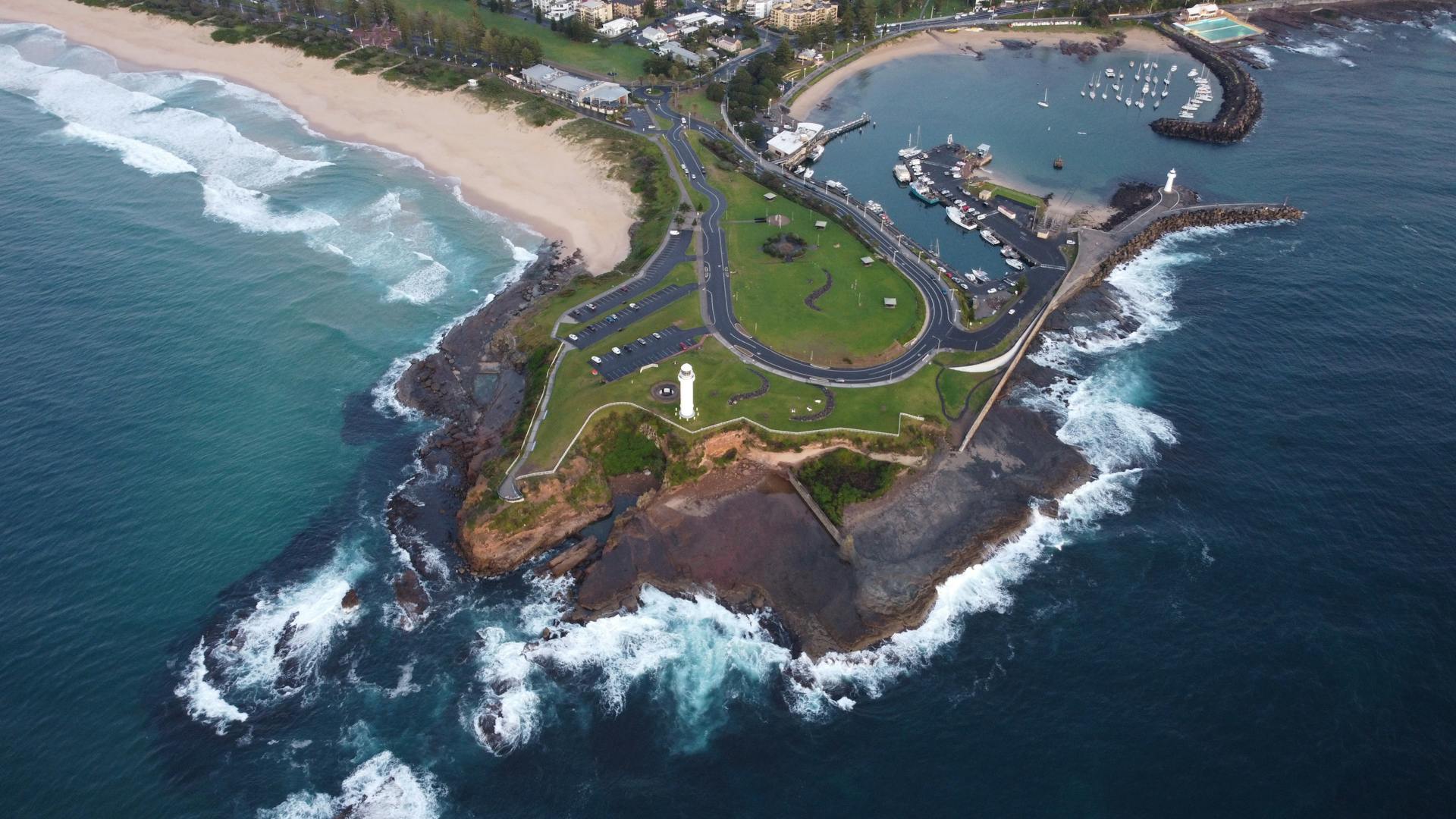
The Southern Coal Company followed suit in 1887 with its own jetty, both jetties being connected to the mines by rail.
In 1888, both jetties were connected to the Sydney to South Coast railway, allowing ships of up to 4000 tons to be loaded.
This direct loading capacity eliminated the need for small coastal colliers to carry coal to Port Jackson for transhipment.
Wollongong Harbour's decline was rapid, with it no longer trading regularly with other ports, except Sydney, by 1901.
Suggestion: Sydney Harbour Trust
Boat Building and Recreation
Wollongong Harbour has a rich history of boat building, dating back to 1909 when the wooden steam tug ss Dumaresq was built.
The Dumaresq was constructed using local and imported timber, with ironbark from Pebbly Beach and spotted gum from Termeil used in its construction.
The tug was launched between the Coast Guard building and the breakwater, where there is now a rock-filled seawall on the land-side of the existing slipway.
Recommended read: Harbour Tug Boats
Proposal and Building
The proposal for a harbour at Wollongong was first made in 1835 by Mitchell, who suggested using convict labour to keep construction costs low.
Mitchell's plan included a breakwater that would extend in a straight line from Wollongong Headland, but there's no evidence it was ever started.
In 1837, Governor Bourke instructed Captain George Barney to design and oversee the construction of a harbour at Wollongong, which would include a 100-foot long, 35-foot wide, and 8-foot deep basin with a stone pier.
The excavation was to be carried out by drilling and blasting behind a cofferdam, and the work was eventually done by up to 300 convicts.
The construction of the harbour was a massive undertaking that required careful planning and execution.
Pilots Slipway
The Pilots Slipway is a significant part of the harbour's history, dating back to the 1844 original slipway. It was later extended in the 1860s as part of the harbour development.
The present slipway is a result of these extensions, with the most recent one taking place in 1905. There is evidence of the original boatshed and winching mechanism used to launch the Pilot Boat.
This historic slipway has been a key part of the harbour's operations, serving as a launching point for the Pilot Boat.
Boat Building
The history of boat building at Wollongong Harbour is a fascinating one. In 1909, the wooden steam tug ss Dumaresq was built at Wollongong Harbour.
Hardwood timber was sourced from the NSW South Coast, with ironbark coming from Pebbly Beach and spotted gum from Termeil. The timber was carried by sea to Wollongong aboard the wooden steamer ss Our Elsie.
Fishing and Recreation
Belmore Basin has been a hub for commercial fishing and recreation for decades. The area was initially used by the commercial fishing fleet, with a slipway constructed in the 1960s to handle large fishing vessels.
In the 1960s, a slipway capable of handling large fishing vessels was constructed near the Lighthouse breakwater. This made it possible for the commercial fishing fleet to operate safely.
The Northern breakwater was constructed in 1966-67 to provide safe anchorage for pleasure craft. This changed the dynamic of the area, as pleasure craft began to use the Basin.
The Fishermans Cooperative, restaurants, and cafes are located in a commercial building near the Central Pier Head. This building was constructed in 1971.
During the 1980s, a timber public jetty was constructed near the former 1856 ISN Co jetty and the 1873 ISCN Co later ISCNSN Co Ltd replacement jetty. This added to the area's recreational facilities.
The Outer Harbour provides safe mooring for recreational vessels and a jetty for visiting vessels. This makes it an ideal spot for boaters to enjoy the area.
The balance of the curtilage is in high demand as open space, scenic viewing points, and recreation including swimming. This shows that the area is not just for fishing and commercial use, but also for leisure activities.
Description and Condition
The Wollongong Harbour Precinct is an area that includes Wollongong Head, Belmore Basin, and the Outer Harbour and breakwaters, Brighton Lawn, Mt Pleasant and Mt Keira tramways alignment, and the beachfront north from the Harbour Northern Breakwater including the two ocean baths.
The precinct is bounded to the north by the southern boundary of the NSW State Heritage listed North Beach Precinct, Cliff Road to the west, the southern side of Wollongong Head to the south, and the Pacific Ocean to the east.
The major features of heritage interest within this area include the Old Court House and the Customs House on the corner of Harbour Street and Cliff Road, Smith's Hill Fort on Cliff Road, and Osborne Park on the western side of Cliff Road.
The condition of the Basin's heritage sea-walls varies from reasonable to good, but there are areas of concern due to localized erosion, weathering, and movement of certain sections of the walls.
Readers also liked: Paldiski North Harbour
Here are the specific areas of concern for the heritage sea-walls:
- Localised erosion of the poorer quality lithic sandstone bedrock resulting in undercutting in the intertidal zone, voids where mortar is missing;
- Weathering of the more exposed or poorer quality lithic sandstone blocks;
- Movement of a section of the 1844 Central Pier wall;
- Ongoing movement evidenced by cracking of block work, rotation of portion of the wall and settlement behind the wall of the Basin wall of the 1844 Central Pier.
Description
The Wollongong Harbour Precinct is an area that includes Wollongong Head, Belmore Basin and the Outer Harbour and breakwaters, Brighton Lawn, Mt Pleasant and Mt Keira tramways alignment, the beachfront north from the Harbour Northern Breakwater including the two ocean baths.
This precinct is bounded by the southern boundary of the NSW State Heritage listed North Beach Precinct to the north.
Wollongong Head, Belmore Basin, and the Outer Harbour and breakwaters are all part of this precinct.
Cliff Road serves as the western boundary of the precinct, while the southern side of Wollongong Head marks the southern boundary.
The major features of heritage interest contained within this area include Smith's Hill Fort on Cliff Road, Osborne Park on the western side of Cliff Road, and the Old Court House and the Customs House on the corner of Harbour Street and Cliff Road.
You might enjoy: Western Harbour (Mariehamn)
Current Condition
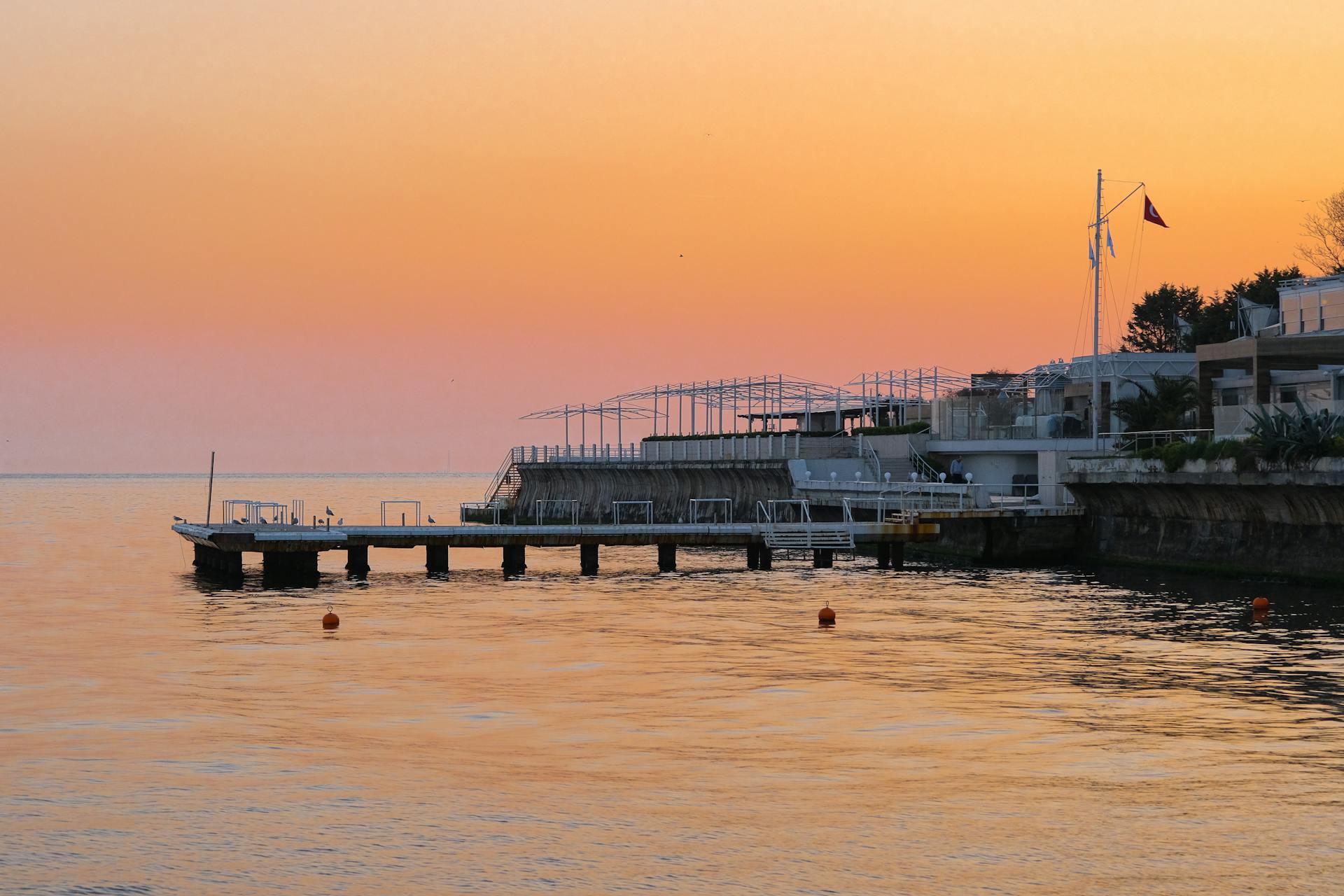
The Basin's heritage sea-walls are in a mixed condition, ranging from reasonable to good. However, there are areas of concern that need immediate attention.
Localised erosion of the poorer quality lithic sandstone bedrock is causing undercutting in the intertidal zone, resulting in voids where mortar is missing. This is particularly problematic in areas where the mortar is missing.
Weathering of the more exposed or poorer quality lithic sandstone blocks is also a concern. These blocks are more susceptible to damage from the elements.
Movement of a section of the 1844 Central Pier wall is another issue that needs to be addressed. This movement is causing cracking of the block work, rotation of a portion of the wall, and settlement behind the wall.
If maintenance and stabilisation of the affected sections of the 1844 walls are not carried out, these walls could become unstable and fail. This is a pressing concern that requires immediate attention.
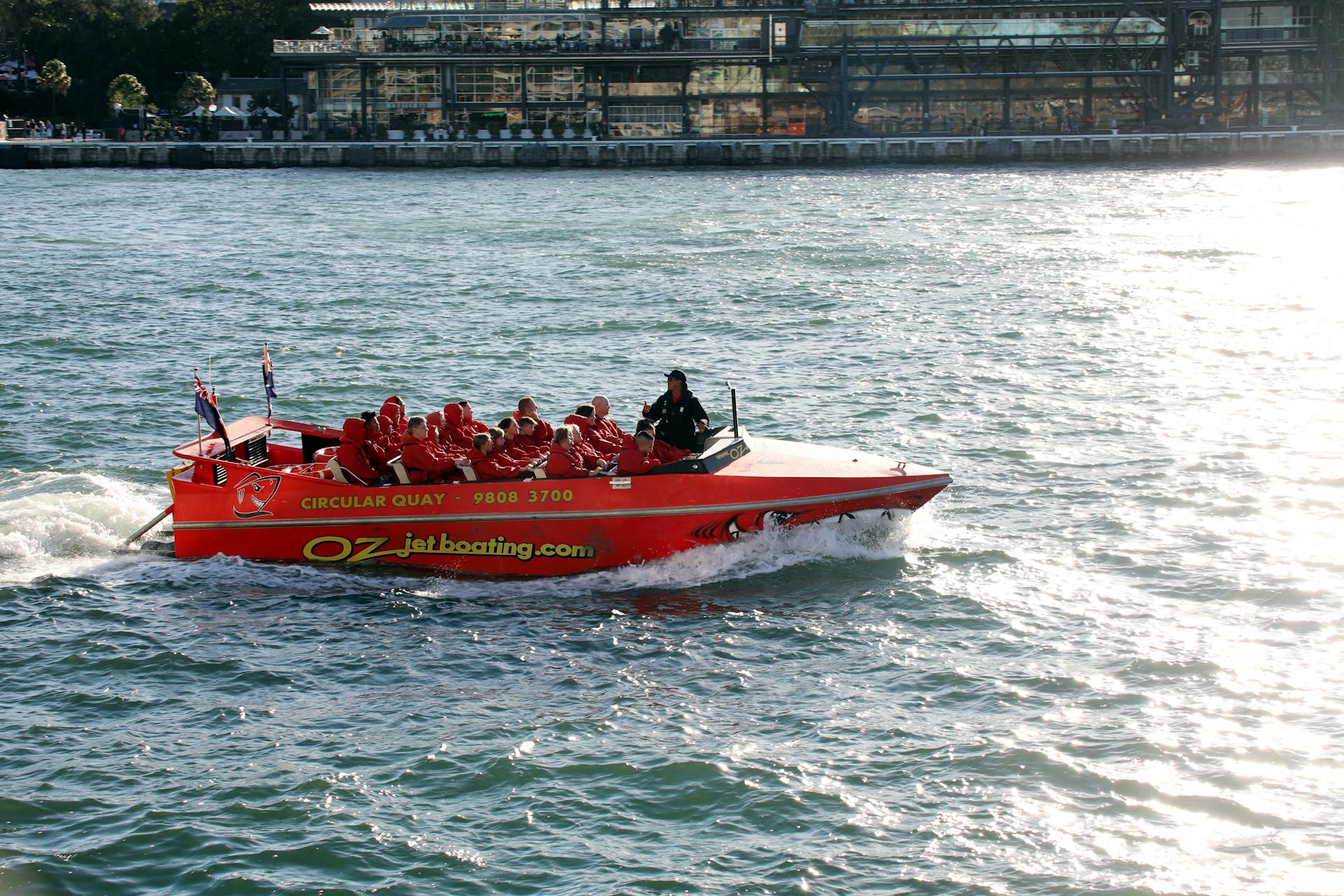
Here are some specific issues with the 1844 walls:
- Localised erosion of the poorer quality lithic sandstone bedrock
- Weathering of the more exposed or poorer quality lithic sandstone blocks
- Movement of a section of the 1844 Central Pier wall
- Cracking of block work, rotation of portion of the wall, and settlement behind the wall
The use of hard cement mortar in earlier repairs has also contributed to localised accelerated weathering of some sandstone blocks. This is a concern that affects not just the 1844 walls, but also the staith wall and sea walls.
Heritage Listings
Wollongong has a rich history, and it's evident in its many heritage-listed sites. One of the most notable is the St Michael's Cathedral on Church Street.
The Wollongong Harbour Precinct, which we'll be exploring in more detail, is just one of the many heritage-listed areas in the city. This precinct is a hub of activity, with the harbour playing a significant role in the city's history.
The Wollongong railway station, a heritage-listed site, is another important part of the city's history. It's a great spot to learn more about the city's past.
The Regent Theatre on Keira Street is a beautiful example of a heritage-listed building. It's a must-visit for anyone interested in architecture.
Here are some of the key heritage-listed sites in Wollongong:
- St Michael's Cathedral, Church Street
- Wollongong railway station, Illawarra railway
- Regent Theatre, 197 Keira Street
- North Beach Precinct, Cliff Road
- Wollongong Harbour Precinct, Cliff Road and Endeavour Drive
Outer and Remaining
The Outer and Remaining areas of the Wollongong Harbour Precinct are just as fascinating as the main hub. The precinct's outer areas are home to a mix of industrial and commercial spaces, with a few pockets of residential areas thrown in for good measure.
The remaining areas of the precinct are largely composed of open spaces and parks, including the scenic Wollongong Botanic Garden. This beautiful green oasis is a peaceful escape from the hustle and bustle of the harbour area.
Related reading: Great Yarmouth Outer Harbour
Outer
The Outer Harbour has a complex history of breakwater construction. The Moriarty 1869 rubble mound breakwater, now precast concrete block armoured and concreted over, is where the lighthouse stands.
The harbour has had its fair share of repairs due to storm damage and settlement since its construction. A short rubble mound concrete block armoured spur breakwater was constructed in the 1890s by the Wollongong Harbour Trust League, but it's now largely forgotten.

The northern rubble mound breakwater was built between 1966 and 1967. This breakwater has also needed periodic repairs over the years.
Here's a brief overview of the breakwaters:
On the seaward side of the Basin, there's a sandstone block wall that was constructed in 1881. It's up to 12 feet high and stretches across the area.
Mt Keira Tramway Bridge Remains
The Mt Keira Tramway Bridge Remains are a fascinating piece of history. Located on the western side of Cliff Road in Osborne Park, they are the remnants of a timber rail bridge that spanned Smith's Creek.
Built in 1864, the bridge was part of the extended tramway track that transported coal from the Mt Keira Osborne-Wallsend escarpment coal mine to Wollongong Harbour.
This tramway line operated until 1933, after which the rails were removed and the deck was lifted from the bridge.
In 1997, the remaining trestles of the bridge were stabilised, allowing for further recording, repair, and site interpretation to take place.
Frequently Asked Questions
Why is Wollongong so popular?
Wollongong's unique combination of industrial activity, scenic coastline, and natural beauty makes it a popular destination. Its stunning beaches and lush rainforest-covered escarpment create a captivating setting that draws visitors and residents alike.
Who owns Wollongong Harbor?
Wollongong Council owns the harbour foreshores, having acquired the land from Australian Iron & Steel between 1937 and 1945.
Where in Australia is Wollongong?
Wollongong is located in southeastern New South Wales, Australia, on the coast of the Tasman Sea. Specifically, it's situated in the Illawarra district.
Sources
- https://en.wikipedia.org/wiki/Wollongong_Harbour_Precinct
- https://placedesigngroup.com/projects/wollongong-harbour-master-plan/
- https://www.illawarramercury.com.au/story/4892605/harbour-precinct-open-to-the-public-for-the-first-time-in-150-years/
- https://www.visitwollongong.com.au/operators/transport-and-tours/tour/working-port-tour/
- https://www.wikiwand.com/en/articles/Wollongong
Featured Images: pexels.com
